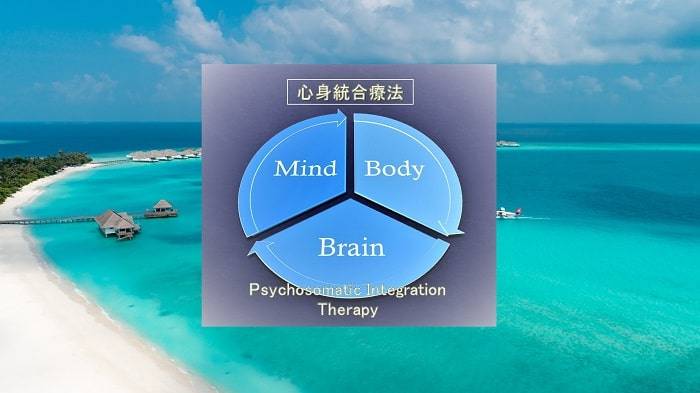
心は本当に痛んでいる
2018年に開催された一般講演会「痛みとは何か?~その深淵なる世界~」。そのパンフレットの一部を下に再現します。
「患部ではなく
事実「被験者に別れた恋人の写真を見せると、その人の脳内では慢性痛に関わる領域のみならず、外傷の痛みをキャッチするエリアまで活性化する」ことが報告されており、認知科学による追証(追い風)はとどまることを知りません。
- 上記パンフレットの続き↓↓↓
講演会の開催から4年が経った2022年、日本の公共放送(NHK)が上記パンフレットの冒頭部分のソース(海外の論文)を紹介しました(→ヒューマニエンス「“痛み” それは心の起源」)。
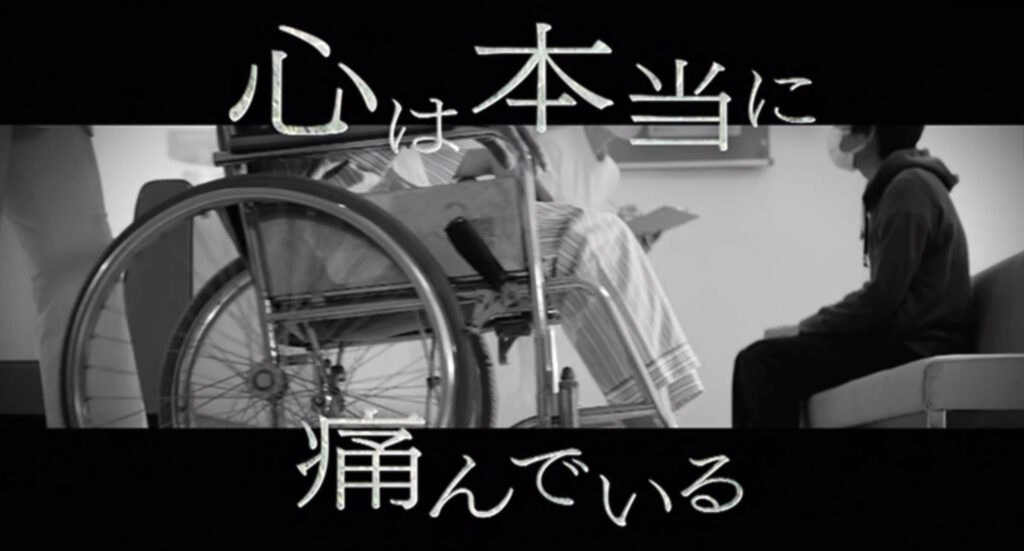
番組中で紹介された実験内容は以下のとおりです。
米国のミシガン大学において、直近6ヵ月のあいだに恋人にフラれた男女40人が集められ、最初に熱刺激による痛みを与えて、その際の脳の反応を調べます。
次に、別れた元恋人の写真を見せて、その際の脳の反応を調べました。すると、驚くべきことに痛みを与えたときと同じ領域が活性化していたのです(下図)。

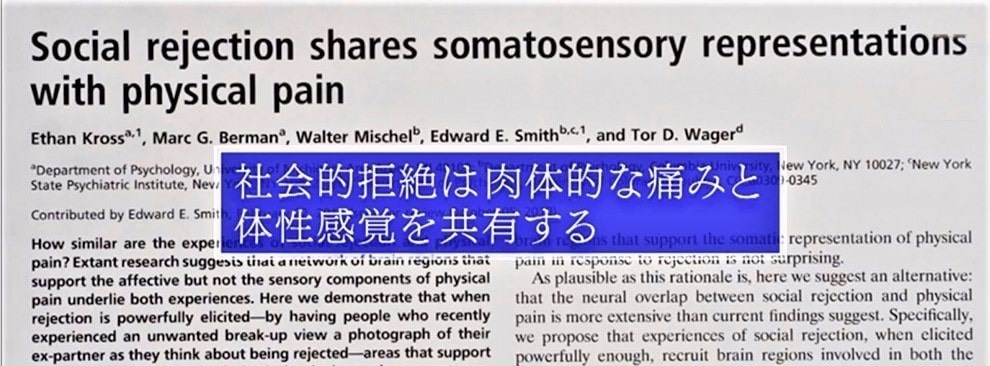
この結果に対しては、様々な解釈が可能です。ひとつは「心の痛みとからだの痛みは脳の次元において本質的に同じ」ということ。私たちが日常的に使う「心が痛い、心が痛む」という表現は決してメタファーではないということです。
もちろん心にはリアルな痛覚はないわけですが、それは意識が形を持った物質ではない、すなわち物理的な刺激を入力する感覚受容器が存在しないだけであって、心の痛みはクオリア(意識が捉える質感)として間違いなく存在しているのです。
私たちはそういうことを本能的に察知しているからこそ、「心が折れる/心が躍る/心が動く/心が沈む」のように、物質的な存在に譬える慣用句を常用しているのだと思います。
痛みと感情の関係
冒頭で紹介したように当会は以前より、痛みは感情と切り離せないこと、ケガの有無に関わらず脳が自主的に生み出す痛みが存在すること、こうした痛みが存外多いことなどを報告してまいりました。
そして、これまでにない新しい痛みの分類や定義を策定しています。『無意識の中で生まれた感情の源泉(情動)がスムースに意識に上らないと、それが一部痛みとなって現れる。こうした痛みをソフトペインと呼ぶ』
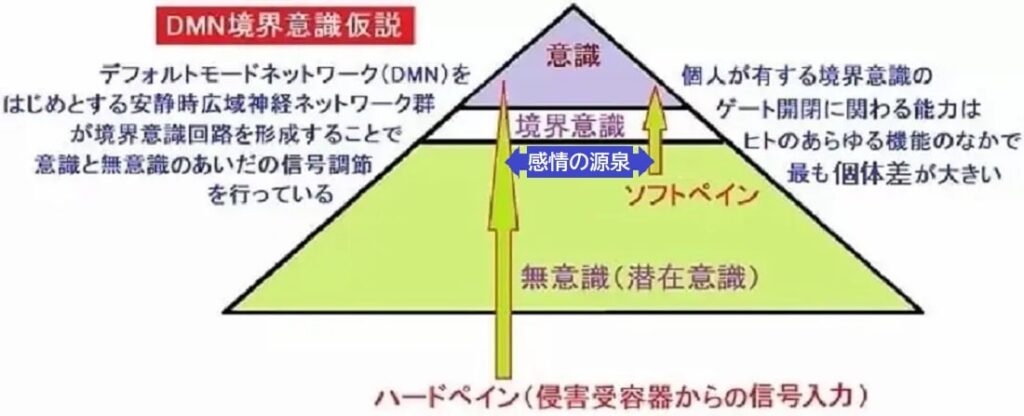
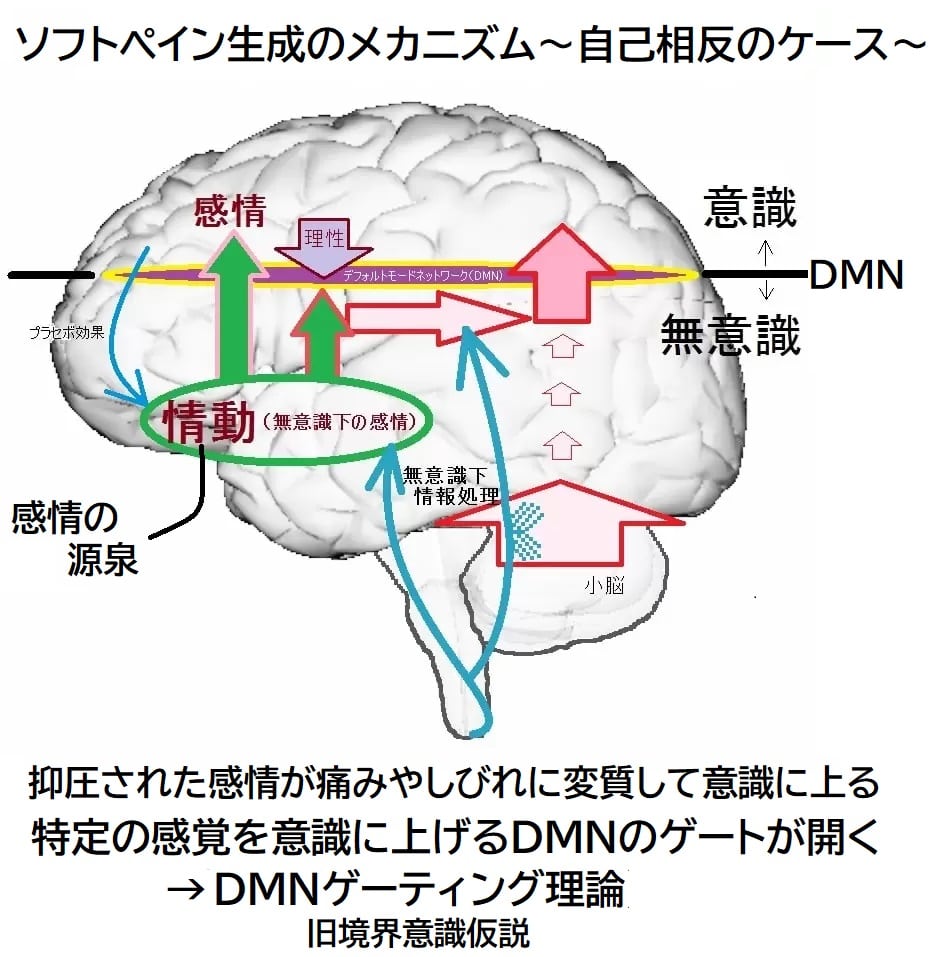
(自己相反とは「本当はそうしたいけれど、でもこうせざるを得ない」というように、個人の中で思いがねじれる心理状態)
ところが、世の中には感情を上手に解放することが苦手な人がいます。また苦手でない場合であっても、或る条件の下で感情解放が許されない場面もあり得るでしょう。
人それぞれ色々な背景があって、理性を優先させなければならないとき、これが長く続くと、すなわち自らの感情を抑え続けると、行き場を失った感情は形を変えて意識に上ってきます。これがソフトペインです。
ソフトペインは肉体次元とは無関係に脳が生み出す感覚であるのに対し、肉体における外傷や炎症による痛み、すなわち組織の障害を知らせる痛みをハードペインと言います。
先に挙げた“失恋と痛みの実験”について考察を進めたとき、当会は「ハードペインも感情の影響を受ける」という解釈を掲げています。
実際、外傷の痛みには個人差が隠れており、同じ場所の同じ程度のケガであっても、人によって痛みの感じ方は様々です。ハードペインと言えども感情の修飾を受けて変質するからです。
先の実験つながりで言えば、熱刺激による痛みを加えた際、「失恋して間もない人」と「熱愛中の人」を比較する実験を行った場合、失恋した人のほうが痛みを強く感じる可能性があります。
先の実験結果は、失恋した脳は痛みに関わる領域が活性化しやすいことを示しているからです。
痛みの個体差
これまで説明してきたように、個人が所有する感受性の問題、そして記憶や経験など複雑な要素が絡み合うことで、「あらゆる痛みには個体差がつきまとう」ことが分かっています。
先の実験は男女40人の脳を調べたわけですが、上記に示した脳の画像は40人の平均値を示しているに過ぎず、実際は40人がまったく同じ反応を示したわけではありません。活動する領域に共通性があったことを示していたのであって、厳密には当該領域の微妙な違いや活動レベルの強度には個体差がありました。
外傷の有無に関わらず、炎症の有無に拠らず、ハードペインであってもソフトペインであっても、どんな痛みであっても、そこには厳然たる個体差という次元が潜在しています。下の画像に示す通り、同じ刺激による痛みであっても、脳の反応は千差万別、十人十色なのです。

しかし現代医学はこうした個体差という次元を軽視もしくは無視する傾向が強く、多くの医療現場でそうした視点が共有されておりません。
日本では、とくに運動器の現場においてその傾向が顕著であり、レントゲンやMRIに映し出された画像上の変化だけを絶対軸にしています(こうした医療哲学を“絶対医学”と言います)。
そのため、骨の変形があっても痛みのない人、軟骨が擦り減っていても痛みのない人、ヘルニアがあっても痛みのない人、脊柱管狭窄があっても痛みのない人たちが大勢いるという事実(EBMにおける世界の常識)は、日本ではまったく顧みられることがありません(→EBMについてはこちらのページをご参照ください)。
当会はウェルビーングの向上において、あらゆるヘルスケアに「脳と心とからだの統合」という視点が必要だと考えています。
これを実践するためには、いかに個体差を見極め、いかに患者さんひとりひとりに合ったアプローチを提供できるかというスタンスが非常に重要です(こうした医療哲学を“相対医学”と言います)。
認知科学統合アプローチ(COSIA)においては、痛みの個体差という次元をベースにして、各症例に対する最適解を見出すスタイル、すなわち個体差を前提にしたオーダーメイドな医療を追究しています。
余談~失恋保険~
さて、ここから先は余興話になりますが、脳内の現象とは言え、失恋した脳がまるでケガを負ったような反応を示すことを鑑みると、「失恋は心のケガ」というメタファーが脳裏をよぎります。
交通事故に遭って、むち打ち損傷を負った方の中には、やるせない気分になり、場合によっては加害者に怒りを覚えるケースもあるでしょう。しかしほとんどの方は加害者に暴力的な報復を加えるようなことはありません。
新聞やテレビで報道されないだけで、実際はそういう事件もゼロではないのかもしれませんが、一般にそうしたケースは認知されていないと思います。
その理由を考えたとき、交通事故の場合は被害者のケアが保障されている保険制度が真っ先に思い浮かびます。治療費や休業補償から通院の交通費に至るまで損保会社が担ってくれます。もちろんそうした手厚いフォローを受けるために自賠責等の保険料を納めているわけですが。
翻って、失恋の場合はどうでしょう?交通事故に対しては損害保険があるわけですが、失恋保険などというものは聞いたことがありません。むち打ちも、失恋も、脳のレベルで言えば、同じようにケガを負っているのに、前者は社会的制度で守られている一方で、後者には何もありません。
同じ失恋でも、「交際を申し込んで“ごめんなさい”という顛末」と「長く付き合って結婚を意識するくらいの熱愛の果てにフラれた場合」では、ダメージの深さが全然違うと思いますが、いずれにしても「脳の次元ではケガをした」のに、でも社会的には何の補償もないわけです。
『肉体のケガに障害保険があるように、心のケガにも障害保険があっていい…!?』
筆者は悲惨なストーカー事件の報道を目にした際、奇天烈な妄想を抱いたことがあります。
↓↓↓ 妄想(当会の活動とは一切関係がありません)↓↓↓
『失恋には人間の脳を破壊する威力がある。ストーカーになる人間は、もともと備わっている危険な心理特性が主要因と考えられるが、なかにはPTSDに近いレベルの脳のダメージを負っているケースも…。
もし社会制度の枠組みの中に、失恋保険というシステムがあったら、どうだろう?
むち打ちになった人が加害者に過剰な怒りをぶつけないのは、医療行為を含む金銭的な補償が得られるからではないのか。もちろんこれが全てではないにせよ、無意識においてそうした背景が影響している可能性は否定できない。
だとしたら、失恋した人間も交通事故と同様の補償が得られる制度があれば、ストーカー事件は減るのではないか?
失恋保険に入っている人は、状況を証明できる何がしらの書類を提出すると、脳のケア(心のケア)に関わる医療費が保険会社から支払われ、その内実によってはうつ病認定や不安障害の認定を得ることも可能で、さらに休業補償も得られる…。
そんな世の中になれば、失恋による脳のダメージを抱え、かつ危険な人格傾向を持つ人も、ストーカーのような行動に出るケースが減るのではないか。
同時に、日本の喫緊の課題である出生率の回復につながるのではないか?若者たちの中に、もし恋愛におびえる心性を抱える人が一定数いるとするならば、恋愛環境を整えていく視点も必要ではないか。
育児環境に投資することも、もちろん大事だが、それ以前に恋愛がなかったら子供は生まれない。だから恋愛に臆病な人たちを減らしていく施策も大事なのではないか。若者たちが青春を謳歌して、安心して恋愛できる環境を築く方策があっていいのではないか。
失恋保険なんて、一見おふざけの話に聞こえるかもしれないが、こんな奇抜なアイデアでも、ユニーク過ぎると思えることでも、少しでも可能性のあることは何でも試していく、それぐらいの行動力がなかったら、日本の人口減少を食い止めることはむつかしい!
経済力の低下著しい日本が、まずやるべきことは少子高齢化による歪みを解消すること。そのためには出生率を上げること。その対策のひとつとして、非現実的ではあるが失恋保険という発想はちょっと面白いかも…!?』
ご参考までに、日本人の生涯未婚率は昭和時代までは5%以下でしたが、平成時代に入ってから(1990年を境に)、急速に増え続けており、2020年時点で「男28.3%、女17.8%」(不詳補完値)となっています。
こうした未婚率の上昇傾向は地方より都市部において顕著であり、たとえば東京では男性の3人に1人、女性の4人に1人が生涯未婚という数字が出ています。
また恋愛に対する調査では独身の18~34歳の内、約半数は「交際そのものを望んでいない」と回答しています。
人口減少に歯止めのかからない国は、数百年~数千年後には無くなってしまう恐れがあると言われています。
大袈裟に思われるかもしれませんが、日本は今、実は存続の危機に瀕しているのだという認識を持っているインフルエンサーもいます。
政党や議員を選ぶときは、人口減少に対する政策も考慮に入れる必要があるのかもしれません。
認知科学統合アプローチ(COSIA)に興味のある方へ
画像ラベリングと痛みの原因診断が乖離する現状において、世界疼痛学会(IASP)は痛みの定義を改訂し、「痛みの感情起源説」にシフトしています。
COSIAに興味のある方は是非一度「医療者・セラピスト専用サイト」にお越しください。貴殿のご参画をお待ちしております。
